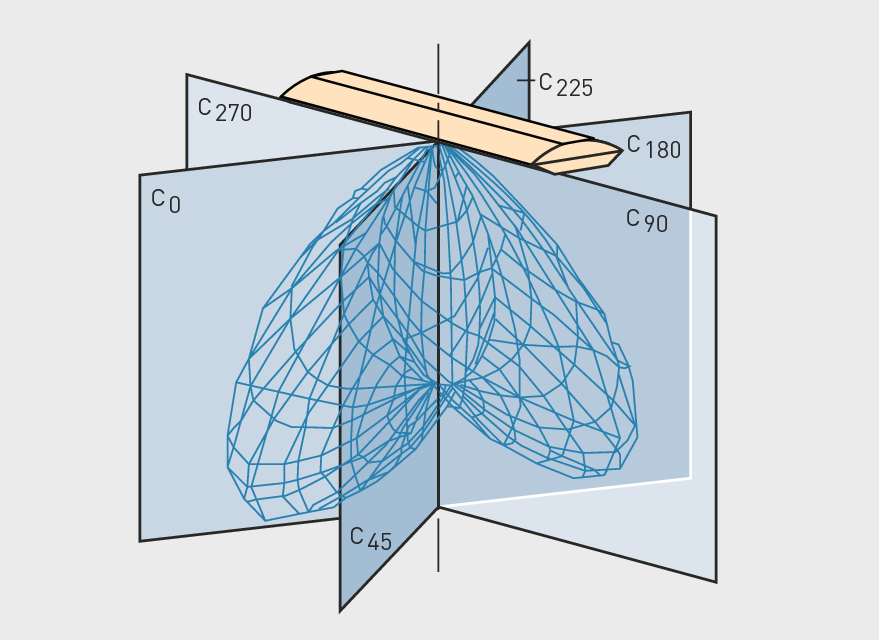Replaceable light source. Source of optical radiation in the visible range (light). Lamps convert electrical energy into optical radiation (luminous efficacy). Moreover, a lamp is furnished with a base matching a socket, which is conceived to facilitate the lamp’s replacement without mandatory deployment of a trained electrician, for example at the end of its service life.
L
(Light Emitting Diode). Crystalline semiconductor producing monochromatic light due to electroluminescence. The wavelength (colour) of the light depends on the LED crystal’s characteristics. White light can be produced by mixing chromatic (red, green, blue) LEDs or through partial conversion of the light of a blue LED by means of a fluorescent substance (see also chapter ).
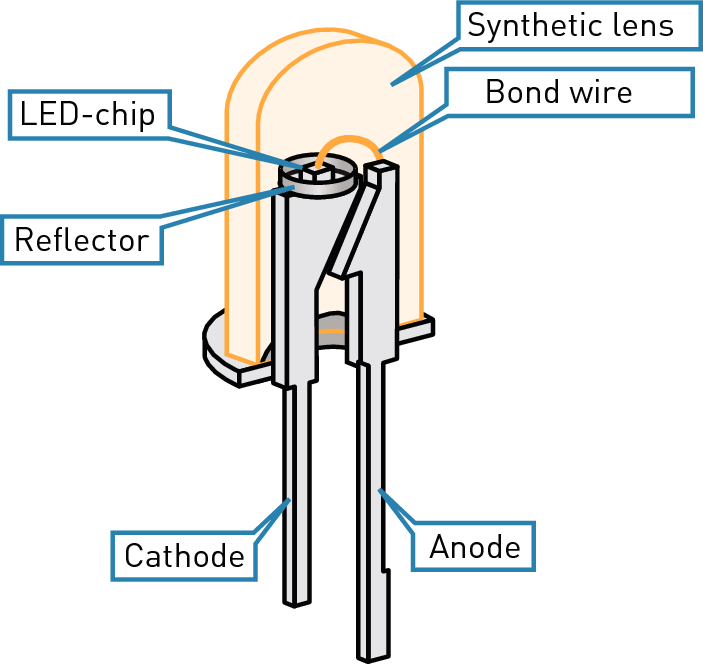
Optical (electromagnetic) radiation in the wavelength range between 380 nm and 780 nm rated by means of the relative spectral degree of luminous efficiency of the human eye.
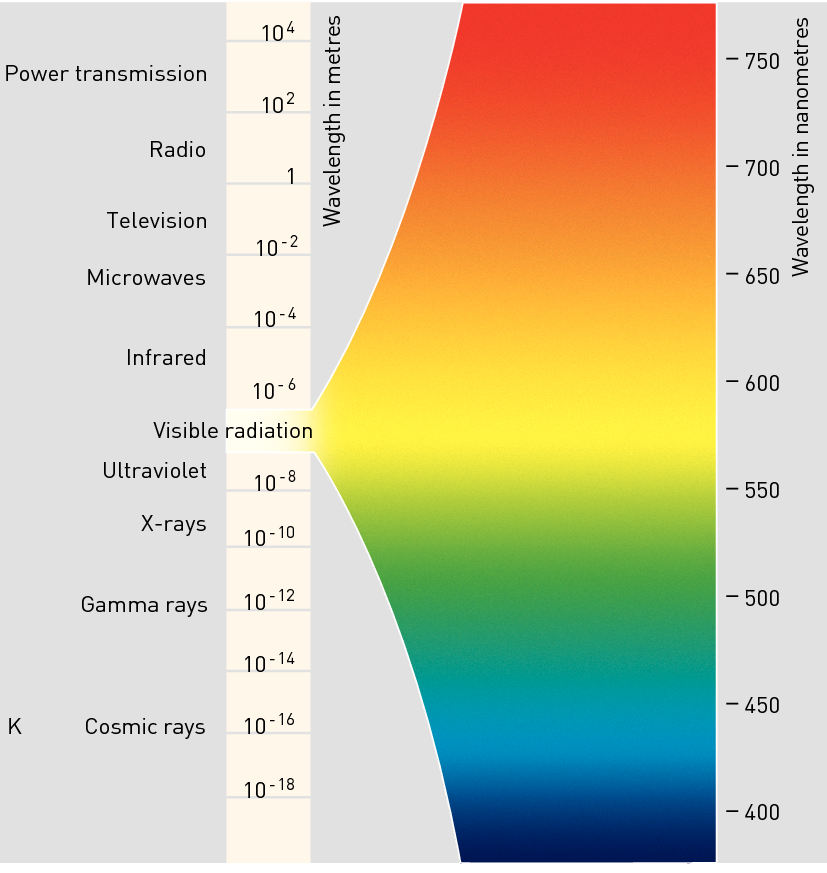
The light colour of e.g. a lamp or daylight refers to the perceived colour of the light emitted by it. It is described by using the colour temperature (TCP – température de couleur proximale) most closely resembling it. Typical light colours are warm white, neutral white and daylight white (see also chapter " light colour").
Unit: Kelvin (K).
(LOR) The light output ratio for luminaires intended for operation with replaceable lamps is defined as follows: The light output ratio RLO is the ratio of the luminous flux Φ(t) emitted by the luminaire at luminaire ambient temperature t and other standardised operating conditions to the sum of the luminous flux ΣΦ0 of the inserted lamps which the lamps each emit using the control gear installed in the luminaire and under the operating conditions the manufacturer bases its luminous flux emissions on. According to applicable standards the luminous flux of lamps and luminaires (including outdoor luminaires) must be measured at an ambient temperature of (25 ± 2)°C.
Device which distributes, filters or converts the light generated by one or more light sources. Where the light source is permanently integrated into the luminaire and does not feature a base intended for its replacement, it is an integral part of the luminaire. Where the light sources are lamps, the luminaire encompasses all parts intended to fix, protect and operate the lamps. This includes wiring as well as devices for connection to the electrical supply grid – however, not the lamps themselves. The luminaire (light fixture) further includes e.g. fittings, control gear, starters, ignitors, cables and terminals, and where applicable also switching and fuse elements; furthermore optical components directing the lamps’ luminous flux as well as protective devices for the optical system.
There is a distinction between light output ratio RLO ("Luminaire efficiency" in US) and optical efficiency of the luminaire (optical light output ratio RLOopt):


ϕ0 is the lamps luminous flux at a surrounding temperature of 25° C.
ϕ(tin) is the lamps luminous flux at the actual temeperature inside the luminaire.
In luminaires intended for incandescent or halide lamps, light output ratio and optical efficiency are identical.
Measure for brightness (visual brightness perception) Formula symbol: L
Unit: cd/m2 (candela per square metre).
The luminance is the quotient of the luminous intensity emitted by a light source and its effective light-emitting surface. Both parameters are generally dependent on the viewing angle in relation to the light source. The effective light-emitting surface is the projection of the light source’s light emission on the plane perpendicular to the viewing direction.

The light source here can be a lamp or luminaire or a body emitting light due to reflection or diffuse transmission.
For a spherically symmetrical free emitter, the luminance is independent of the angle
L(γ) = const.
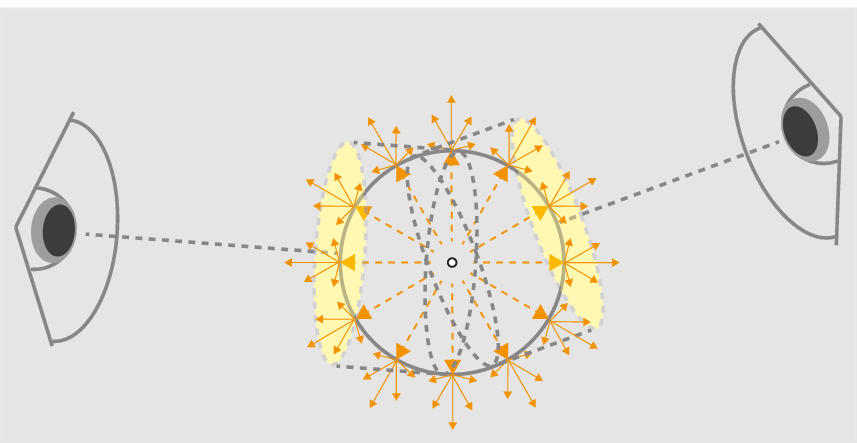
A´ and A are identical.
For luminaires with plane light emitting surfaces, the following applies:

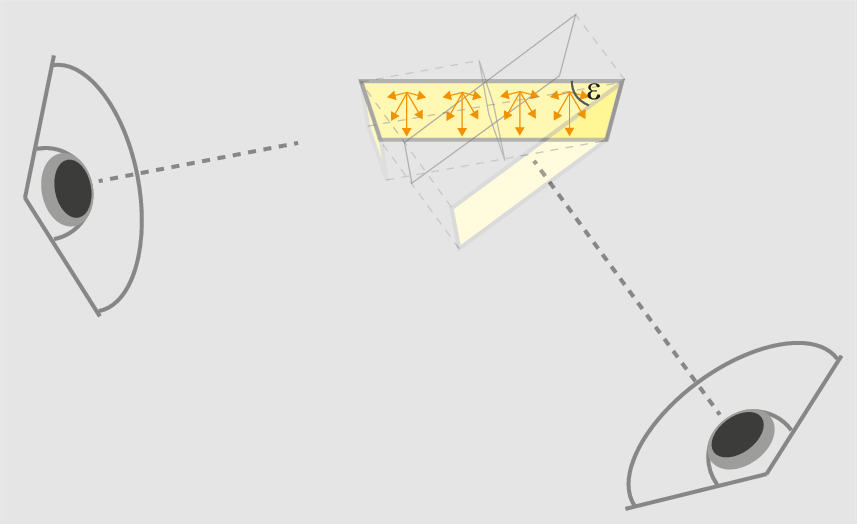
For even surfaces with entirely diffuse reflection and one reflectance value, the perceived luminance, based on the illuminance incident on the surface, yields a constant value.

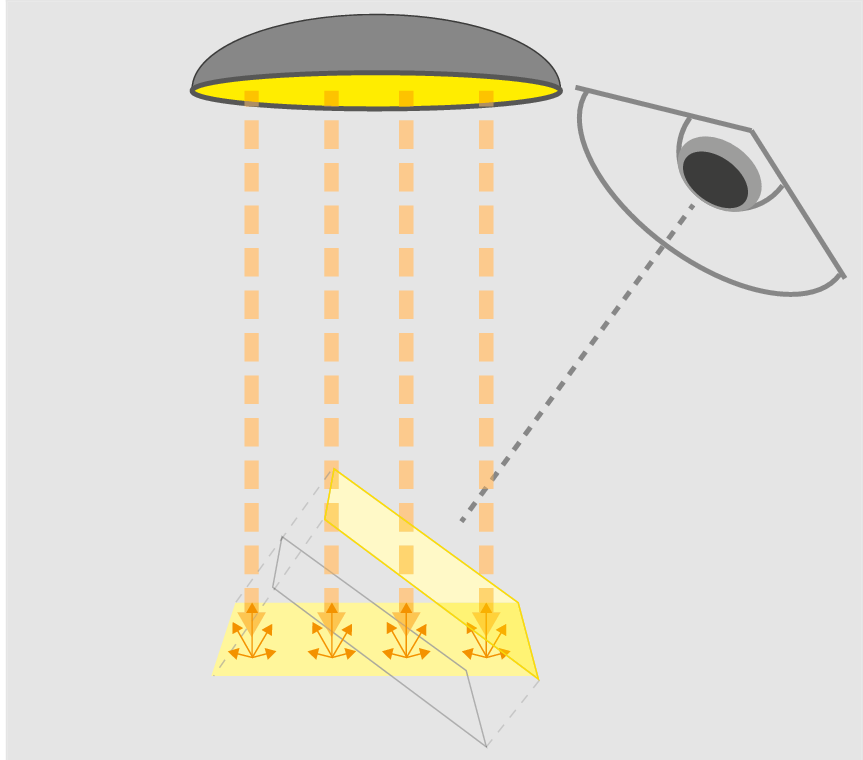
The impression of brightness and the visual performance of the human eye are determined by the luminance. However, in indoor light planning practice, illuminance, which is easier to determine, is used. Sufficiently high reflectance values are assumed for work surfaces. Where applicable, illuminance must be increased accordingly to attain the required luminance and visual performance.
Quotient of the luminous flux emitted by a luminaire and the electrical power consumed by it. This parameter is particularly relevant for luminaires with LED and OLED.
Unit: lumen/Watt (lm/W).
For luminaires intended for operation with replaceable lamps it is important to observe that light output ratio must be considered regarding luminous flux, and electrical loss consumed by control gear must be considered regarding electrical power.
Ratio of the spectral radiant flux at a defined reference wavelength λ, e.g. 555 nm for the eye adapted to light, to the radiant flux at another wavelength, which results in the same perception of brightness. For instance: The luminous efficiency describes the relative sensation magnitude of the human eye at different wavelengths of equal spectral radiant flux in the range of 380 nm to 780 nm, in relation to its maximum, which peaks at a wavelength of 555 nm for an eye adapted to light, and at 507 nm for an eye adapted to darkness. There is a distinction between the relative spectral luminous efficiency functions for photopic vision (for the eye adapted to light) V(λ), reaching its maximum at 555 nm, and for scotopic vision (for the eye adapted to darkness) V´( λ), reaching its maximum at 507 nm (cf Adaptation). Between the two lies the portion of mesopic vision, which is determined, depending on the level of adaptation, either predominantly by the retinal cones responsible for light and colour perception, or predominantly by the retinal rods merely responsible for light perception and incapable of colour perception.
For comparison, the chart demonstrates circadian function C(λ) with a maximum at roughly 480 nm (see also Circadian system), which is responsible for control of the human biological clock (control of the day-nightrhythm, cf. Circadian system).
(Φ) Luminous flux is the radiant flux rated with the degree of luminous efficiency of the human eye. It is the photometric performance parameter of a light source. A three-band 58 W fluorescent luminaire lamp using electronic control gear ECG has a luminous flux of 5.000 lm. An LED luminaire for system ceilings with dimensions of 625 mm x 625 mm or 600 mm x 600 mm typically has a luminous flux of ca. 4.000 lm.
Unit: lumen (lm).
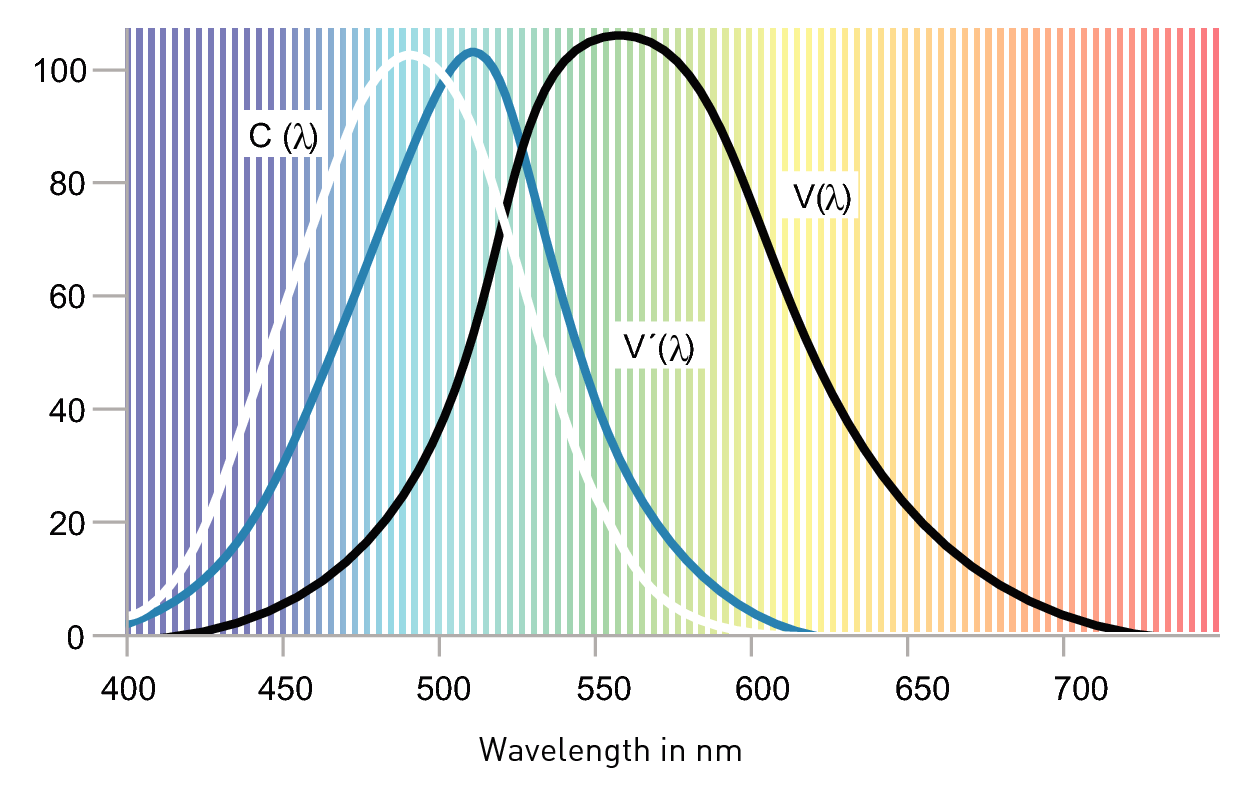
(I) Quotient of the luminous flux emitted by a light source in a certain direction and the solid angle element ΔΩ the radiation is passing through. The spatial distribution of the luminous intensity of a lamp or a luminaire is specified by its luminous intensity distribution curve.

Unit: candela (cd), 1 cd = 1 lm/sr.
Within the SI (système international), luminous intensity is the photometric base parameter. The candela (cd) thus is an SI unit.
The luminous intensity distribution curve is a two-dimensional representation of the spatial distribution of the luminous intensity of lamps and luminaires. The more common three-dimensional representation is the luminous intensity distribution model. The luminous intensity distribution curve is created by subtending a vertical origin plane with the luminous intensity distribution model. Catalogue representations usually depict the so-called C90 and C0 planes, which are defined with reference to a linear luminaire as the directions along the lamp axis and orthogonally to it. The luminous intensity distribution model as well as the luminous intensity distribution curves are usually represented in polar coordinates and standardised to 1.000 lm of the luminous flux emitted by the light source (see also chapter "luminous intensity distribution curves").
The unit for graphic representation of the luminous intensity distribution curve hence is cd/klm.
